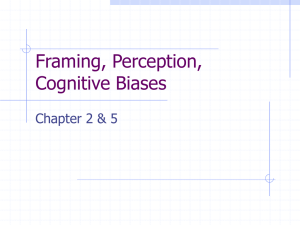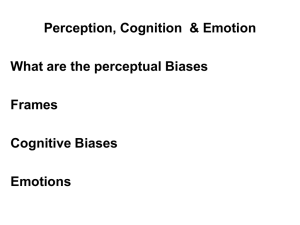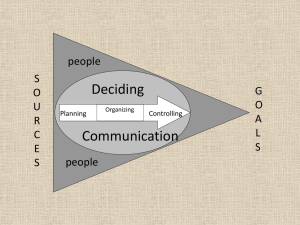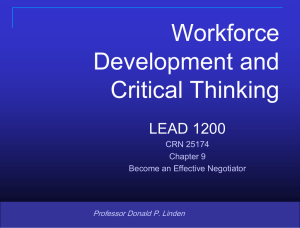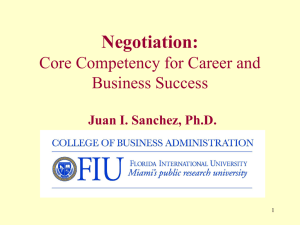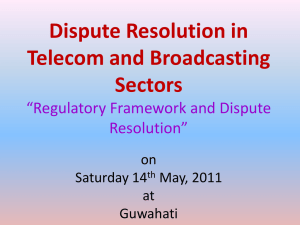Perception, Cognition & Emotion in Negotiation
advertisement
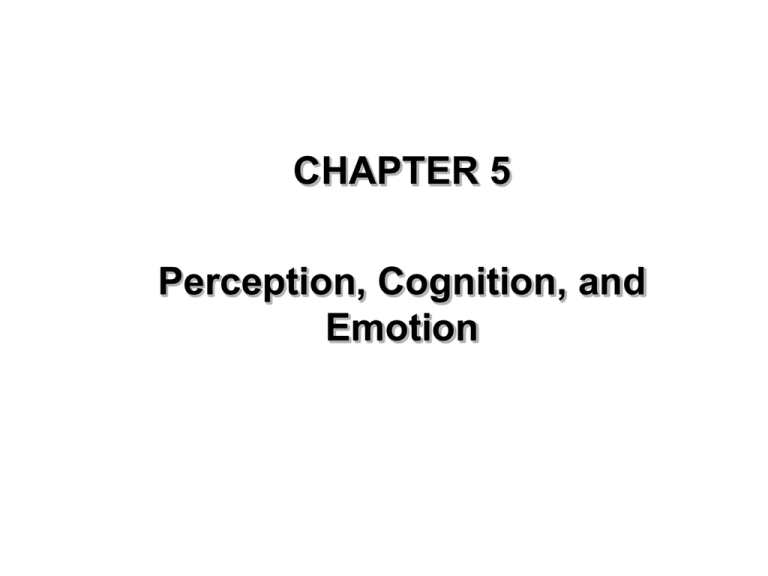
CHAPTER 5 Perception, Cognition, and Emotion The Titles 1. Perception 2. Framing 3. Cognitive Biases in Negotiation 4. Managing Misperceptions and Cognitive Biases in Negotiation 5. Mood, Emotion, and Negotiation 6. Chapter Summary 1. Perception • Perception Defined Perception is the process by which individuals connect to their environment. The process of ascribing meaning to message and events is strongly influenced by the perceiver’s current state of mind, role, and comprehension of earlier communications. • Perception Distortion In a given negotiation, the perceiver’s own needs, desires, motivation, and personal experiences may create a predisposition about the other party (preconceived view). This is cause for concern when it leads to biases and errors in perception and subsequent communication. The Perceptual Process • Figure 5.1 Stimulus Attention Recognition Translation Behavior Perception • Perception is a “sense-making ” process; people interpret their environment so that they can respond appropriately. Perception Distortion -1 • Stereotyping It occurs when one individual assigns attributions to another solely on the basis of the other’s membership in a particular social or demo-graphic category. • Halo Effects It occurs when people generalize about a variety of attributes based on the knowledge of one attribute of an individual. Perception Distortion -2 • Selective Perception. It occurs when the perceiver singles out certain information that supports or reinforces a prior belief and filters out information that does not confirm that belief. • Projection. It occurs when people assign to others the characteristics or feelings that they possess themselves. It usually arises out of a need to protect one’s own self-concept—to see oneself as consistent and good. 2. Framing • A frame is the subjective mechanism through which people evaluate and make sense out of situations, leading them to pursue or avoid subsequent actions. • The popularity of framing has come with the recognition that often two or more people who are involved in the same situation or in a complex problem see it or define it in different ways. • Frames are critical in negotiation for several reasons. Understanding framing helps negotiators evaluate the process, and better controlling it. (p.135) 2.1 Types of Frames (1) Substantive—what the conflict is about. (2) Outcome—a party’s predisposition to achieving a specific result or outcome. (3) Aspiration—a predisposition toward satisfying a broader set of interest or needs. (4) Process– how the parties will go about resolving their dispute. (5) Identity– how the parties define “who they are”. (6) Characterization—how the parties define the other parties. (7) Loss-gain—how the parties define the risk or reward associated with particular outcomes. 2.2 How Frames Work in Negotiation • Negotiators can use more than one frame. • Mis-matches in frames between parties are sources of conflict. • Particular types of frames may lead to particular types of agreements. • Specific frames may be likely to be used with certain types of issues. • Parties are likely to assume a particular frame because of various factors (Box 5.1, p.139). 2.3 Another Approach to Frames: Interests, Right, and Power Parties have a choice about how they approach a negotiation in terms of interests, rights, and power, the same negotiation can be framed in different ways and will likely lead to different consequences • Illustration: the situation of a student who has a dispute with a local car repair shop over the cost of fixing an auto (p. 140) 2.4 The Frame of an Issue Changes as Negotiation Evolves • At least four factors can affect how the conversation is shaped: (1) Negotiators tend to argue for stock issues, or concerns that are raised every time the parties negotiate. (2) Each party attempts to make the best possible case for his or her preferred position or perspective. (3) Frames may define major shifts and transitions in a complex overall negotiation. (4) Multiple (agenda) items operate to shape issue development (e.g. addition, deletion, packaging). Reframing The process of reframing, i.e. the manner in which the thrust, tone, and focus of a conversation change as the parties engage in it. (p. 142) e.g. Focus is changed (ref. Table 3.1 Refocusing Questions to Reveal Win-Win Options, p.86) for effect. Case illustration: ?? Whether intentional or emergent, reframing introduces a new way to approach the problem (a new perspective). Q: What does the Cartoon (p.142) mean to you in the context of “framing”? 2.5 Summary-1 • Framing is about focusing, shaping, and organizing the world around us---making sense of complex realities and defining them in ways that are meaningful to us. (what?) • Different types of frames exist, which helps to understand strategic choices in negotiation. (how?) • How a negotiation problem is defined or framed, and reframed are critical elements for negotiators to consider in developing and implementing their strategy. (why?) 2.5 Summary-2 Prescriptive advices about problem framing (A negotiator Must/should bear in mind) : (1) Frame shape what the parties define as the key issues and how they talk about them. (2) Both parties have frames. (3) Frames are controllable, at least to some degree. (4) Conversations change and transform frames in ways negotiators may not be able to predict but may be able to control. (5) Certain frames are more likely than others to lead to certain types of processes and outcomes. 3. Cognitive Biases in Negotiation -1 • Irrational Escalation of Commitment. It is an tendency for an individual to make decisions that stick with a failing course of action. Escalation of Commitment is due in part to biases in individual perception and judgment. One way to combat these tendencies is to have an advisor to serve as a reality checkpoint. • Mythical Fixed-Pie Belief. The tendency to see negotiation in fixed-pie terms varies depending on how people view the nature of a given conflict situation. It can also be diminished by holding negotiators accountable for the way the negotiate. 3. Cognitive Biases in Negotiation -2 • Anchoring and Adjustment The choice of an anchor might well be based on faulty or incomplete information and thus be misleading in and of itself. Through preparation, along with the use of devil’s advocate or reality check, can help prevent errors . • Issue Framing and Risk. The way an issue is framed influences how negotiators perceive risk and behave in relation to it. The tendency to either seek or avoid risk may be based on the reference point against which offers and concessions are judged. 3. Cognitive Biases in Negotiation-3 • Availability of Information. Negotiators must also be concerned with the potential bias caused by the availability of information or how easy information is to retrieve. The availability of information also affects negotiation through the use of established search patterns. • The Winner’s Curse . The winner’s curse refers to the tendency of negotiators to settle quickly on a item and then subsequently feel discount about a negotiation win that comes too easily. The best remedy for winner’s curse is to prevent it from occurring. 3. Cognitive Biases in Negotiation -4 • Overconfidence It is the tendency of negotiators to believe that their ability to be correct or accurate is greater than is actually true. It has a double-edged effect. It appears that negotiators have a tendency to be overconfident about their own abilities and that this overconfident affects a wide variety of perceptions and behaviors. • The Law of Small Numbers. It applies to the way negotiators learn and extrapolate from their own experience. Example of “hot hand ” fallacy. 3. Cognitive Biases in Negotiation -5 • Self-Serving Biases Fundamental Attribution Error. The effects of self-serving biases. Self-serving biases have recently been shown to influence perceptions of fairness in a negotiation context. Perceptual error may also be expressed in the form of biases or distortions in the evaluation of data. 3. Cognitive Biases in Negotiation -6 • Endowment Effect. It is the tendency to overvalue something you own or believe you possess. In negotiation, the endowment effect can lead to inflated estimations of value that interfere with reaching a good deal . • Ignoring Other’s Cognitions . • Reactive Devaluation. It is the process of devaluing the other party’s concessions simply because the other party made them. Such devaluation may be based in emotionality or on distrust fostered by past experience. 4. Managing Misperceptions and Cognitive Biases in Negotiation • They are typically arise out of conscious awareness as negotiators gather and process information. Box 5.4 presents a sizeable inventory of the variety of decision traps that can occur. • Merely discussing how to set opening offers, aspiration levels, and bottom lines with team members will not reduce the effects of perceptual biases. • Careful discussion of the issues and preferences by both negotiators may reduce the effects of perceptual biases. • Reframing. 5. Mood, Emotion, and Negotiation-1 • The role of mood and emotion in negotiation has been subject of an increasing body of recent theory. • The distinction between mood and emotion is based on three characteristics: specificity, intensity, and duration. • Some select findings are available as following. 5. Mood, Emotion, and Negotiation-2 Negotiations Create Both Positive and Negative Emotions Most researchers agree that emotions tend to move the parties toward some of action I their relationship, such as initiating a relationship, maintaining to fixing the relationship, or terminating the relationship. Positive Emotions Generally Have Positive Consequences For Negotiations. Positive feelings are more likely to lead the parties toward more integrative processes. Positive feelings are also create a positive attitude toward the other side. Positive feelings promote persistence. 5. Mood, Emotion, and Negotiation-3 Aspects of the Negotiation Process Can Lead to Positive Emotions Positive feelings may result from fair procedures during negotiation. Positive feelings may result from favorable social comparisons. Negative Emotion Generally Have Negative Consequences for Negotiators Negative Emotions may lead parties to define the situation as competitive or distributive. Negative Emotions may undermine a negotiator’s ability to analyze the situation accurately. Negative Emotions may lead parties to escalate the conflict. Negative Emotions may lead parties to retaliate and may thwart integrative outcomes. 5. Mood, Emotion, and Negotiation-4 Aspects of the Negotiation Process Can Lead to Negative Emotions Negative Emotions may result from a competitive mindset. Negative Emotions may result from impasse. The Effects of Positive and Negative Emotion in Negotiation. Positive feelings may have negative consequences. Negative feelings may create positive outcomes • Emotions Can Be Used Strategically as Negotiation Gambits Given the power that emotions may have in swaying the other side toward one’s own point of view, elements may also be used strategically and manipulatively as influence tactics within negotiation. 6. Chapter Summary • In this chapter we have taken a multifaceted look at the role of perception, cognition, and emotion in negotiation. • First we presented a brief overview of the perceptual process and discussed four types of perceptual distortions, then turned to a discussion of how framing influences perceptions in negotiation and how reframing and issue development both change negotiator perceptions. • And then we reviewed a research findings of cognitive biases in negotiations.
